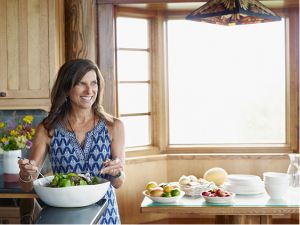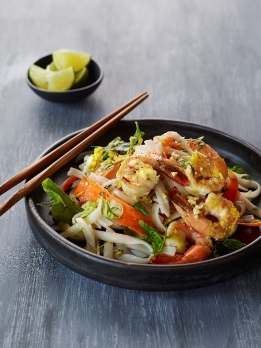Food-loving physician turned chef, Annie Fenn, provides brain-smart ingredients and recipes to show that eating to maintain brain health is easy, accessible, delicious, and necessary for everyone.
 The foods we choose to eat (or not) sit at the core of the Alzheimer’s epidemic. They are also at the heart of the solution. Annie Fenn, doctor, and chef, presents a new way to think about brain health: it begins in the kitchen. With her new cookbook, The Brain Health Kitchen, home cooks will learn exactly how making the right choices about the foods we select and cook, and how we eat them, can keep our brains younger, sharper, more vibrant, and much less prone to dementia.
The foods we choose to eat (or not) sit at the core of the Alzheimer’s epidemic. They are also at the heart of the solution. Annie Fenn, doctor, and chef, presents a new way to think about brain health: it begins in the kitchen. With her new cookbook, The Brain Health Kitchen, home cooks will learn exactly how making the right choices about the foods we select and cook, and how we eat them, can keep our brains younger, sharper, more vibrant, and much less prone to dementia.“Food choices are at the heart of the solution to Alzheimer’s and dementia. I’ve written this book to help you take care of your brain while still eating delicious food,” Annie says. “The earlier you begin eating with brain health in mind, the better. In doing so, you will cultivate a brain that is resilient to age-related cognitive decline from all causes, especially Alzheimer’s.”
Scientific studies have shown that diets high in foods with powerful neuroprotective properties lower their risk of Alzheimer’s and dementia. One such diet, the MIND diet, a spin-off of the Mediterranean and DASH diets, emphasizes the foods that are most neuroprotective—berries, leafy greens, vegetables, fish and seafood, whole grains, nuts and seeds, poultry, beans and legumes, olive oil, and red wine.
The results of a study of the MIND diet showed that when participants adhered to the MIND guidelines most closely, there were 53% fewer cases of Alzheimer’s after just four and a half years. Even participants who followed the diet less rigorously had an astounding risk reduction of 35%. In addition, participants who followed the diet most closely over time showed improvement in cognitive function.
In The Brain Health Kitchen cookbook, Annie takes a more targeted approach, beginning with 100 recipes that incorporate brain-healthy foods into everyday meals. Her recipes are based on the MIND and Mediterranean diet studies along with several other sources. “From these studies I developed my own set of guidelines, The Brain Health Kitchen Food Guidelines, that combines dietary patterns while emphasizing a more plant-forward way of eating, with fewer servings of animal products than MIND and Mediterranean diets do.”
The Brain Health Kitchen Cookbook provides valuable information on brain health, how to stock your “brain health kitchen,” as well as strategies for creating a brain-friendly dietary pattern, including choosing meats that fuel instead of harm; understanding the nuances between “good” and “bad” fats; embracing methods that preserve nutrients, such as braising and steaming; making sure to drink the right beverages; and addressing holistic issues like how diverse your food choices are and how beneficial it is to share meals with family and friends.Some of Annie’s delicious brain health recipes in The Brain Health Kitchen include:
– Caramelized Apple and Quinoa Pancakes
– Strawberry-Avocado Salad with Salmon, Basil, and Lime
– Zucchini Lasagna with Spinach Tofu Ricotta
– Crispy Cauliflower Tacos with Creamy Red Pepper Sauce
– Miso-Glazed Cod with Rice and Gingery Green Beans
– Spiced Scallops with Curried Beluga Lentils
– Grilled Shrimp Skewers with Asparagus and Quinoa-Pecan Pilaf
– Marinated Steak with Warm Kale Salad and Sweet Potatoes
– Coffee Berry Smoothie
– Chewy Chai-Spiced Chickpea Cookies
– Glazed Citrus, Almond, and Olive Oil Cake
Shifting to and sticking with a brain healthy diet is your first and best line of defense against the heartbreaking diseases of Alzheimer’s and dementia. And it works for everyone—omnivores, pescatarians, vegetarians and vegans, and the gluten-intolerant.
“Food is your most powerful tool to resist cognitive decline with age. Unlike many health-centric cookbooks, my approach isn’t about a strict plan. Brain health eating is about making food choices that will have staying power for the rest of your life.”
 |
DR. ANNIE FENN is the founder of the Brain Health Kitchen, the only cooking school of its kind focused exclusively on brain health and helping people prevent cognitive decline through food and lifestyle. After twenty years as a board-certified ob-gyn, she traded in her stethoscope for an apron to pursue her passion for the culinary arts. But it was her mother’s diagnosis with dementia that helped Annie find her path and her new calling, one that enabled her to not only help her mother but also create significant and meaningful impact for others. Annie lives in Jackson, Wyoming. She writes a twice-weekly newsletter at brainhealthkitchen.substack.com and posts on Instagram at @brainhealthkitchen.
Try this delicious brain healthy recipe:
LEMONGRASS SHRIMP AND RICE NOODLE SALAD
SERVES 4
Think of this fresh and crunchy salad as a cross between shrimp pad Thai and a spicy noodle salad. Although I love traditional pad Thai, with its stir-fried noodles and tangy tamarind sauce, at home I am more likely to go light on the noodles and heavy on the vegetables. This dish is especially good with Forbidden Rice noodles, a purple-black variety made from anthocyanin- rich Forbidden Rice (aka black). If you can’t find it, use regular rice or brown rice noodles instead.
There’s really no substitute for the intense, citronella-like aroma and flavor that fresh lemongrass adds to the shrimp. In a pinch, you can get by using lemongrass paste in a tube (use 2 tablespoons paste for 3 tablespoons freshly chopped). The good news is, most grocery stores now carry fresh lemongrass stalks. Look for them in the produce section next to the ginger.
 |
INGREDIENTS:
¼ cup (60 ml) fresh lime juice
¼ cup (60 ml) rice vinegar
1½ to 2 teaspoons sambal oelek (Indonesian fresh chili paste)
½ pound (225 g) Forbidden Rice noodles (or thin, pad Thai–style rice noodles)
1 tablespoon avocado oil
1 large shallot (5 ounces/ 140 g), finely chopped (about ½ cup)
3 tablespoons finely chopped lemongrass, pale, tender centers only
One 1-inch (2.5 cm) piece fresh ginger, grated (about 1 tablespoon)
3 large garlic cloves, chopped (about
1 tablespoon)
1 pound (455 g) medium shrimp (about 30), peeled and deveined (see Tip)
3 medium carrots (12 ounces/340 g), shaved into ribbons with a vegetable peeler
2 loosely packed cups (80 g) tender lettuces (butter, Bibb, or baby romaine), torn into bite-size pieces
2 cups (60 g) chopped fresh mixed herbs (mint, basil, and cilantro leaves), plus more for garnish
½ cup (70 g) raw peanuts, roughly chopped
Lime wedges
1. Stir together the lime juice, vinegar, and 1½ teaspoons of the sambal oelek (more if you prefer a spicier dish) in a large bowl. Set aside, reserving 2 tablespoons of the dressing to drizzle on the finished dish.
2. Bring a large pot of water to a boil. Add the noodles and cook, stirring occasionally until tender, 5 to 6 minutes. (Or follow the package directions, as some rice noodles will cook by soaking in hot water.) Drain well, add to the bowl with the dressing, toss, and set aside.
3. Heat the oil in a large nonstick skillet over medium heat. Add the shallot, lemongrass, and ginger and cook until the shallot is translucent, 5 to 7 minutes. Add the garlic and the shrimp, stir to coat with the lemongrass mixture, and cook until the shrimp are just pink on both sides, about 4 minutes total. Turn off the heat and set aside.
4. Add the carrots, lettuce, and herbs to the bowl of noodles. Toss well and divide among shallow bowls. Top with the shrimp, then sprinkle with the peanuts and more herbs. Just before serving, drizzle with the reserved dressing. Serve warm, at room temperature, or chilled, with lime wedges alongside.
TIP: When purchasing shrimp, look for American wild-caught shrimp. Shrimp imported from other countries is more likely to be contaminated with environmental toxins, fraudulently labeled, and the result of unethical labor practices. If purchasing frozen shrimp at the grocery store, look for peeled, tail-on shrimp for the best product. Cleaning the shrimp of its innards takes only a minute and ensures your shrimp will be safe to eat. Just take a sharp knife along the back and under the belly and remove any dark-colored debris. Or ask the fishmonger at the grocery store to clean them for you. As for canned shrimp: don’t buy it. Most is imported from countries with questionable farming practices and heavy use of antibiotics.
SCIENCE BITE: ASTAXANTHIN IN SHRIMP
Shrimp is rich in the antioxidant astaxanthin, a member of the carotenoid family of nutrients. Animal studies have documented that astaxanthin exerts impressive neuroprotective effects on cognition and memory. Its antioxidant power is active right where the brain is most vulnerable to amyloid deposition—in the hippocampus. Scientists hope to prove that getting enough astaxanthin in the diet has the same neuroprotective properties in human brains, and it is being evaluated as a possible therapeutic agent for Alzheimer’s and Parkinson’s diseases. Besides shrimp, crab and scallops are also rich in astaxanthin.
Disclaimer:
Recipe and photo reprinted with permission from The Brain Health Kitchen Cookbook by Annie Fenn . Photo by Alexandra Grablewski Artisan/2023
Cover photo courtesy
 La Familia de Broward Una herramienta útil para las necesidades de las familias hispanas
La Familia de Broward Una herramienta útil para las necesidades de las familias hispanas





